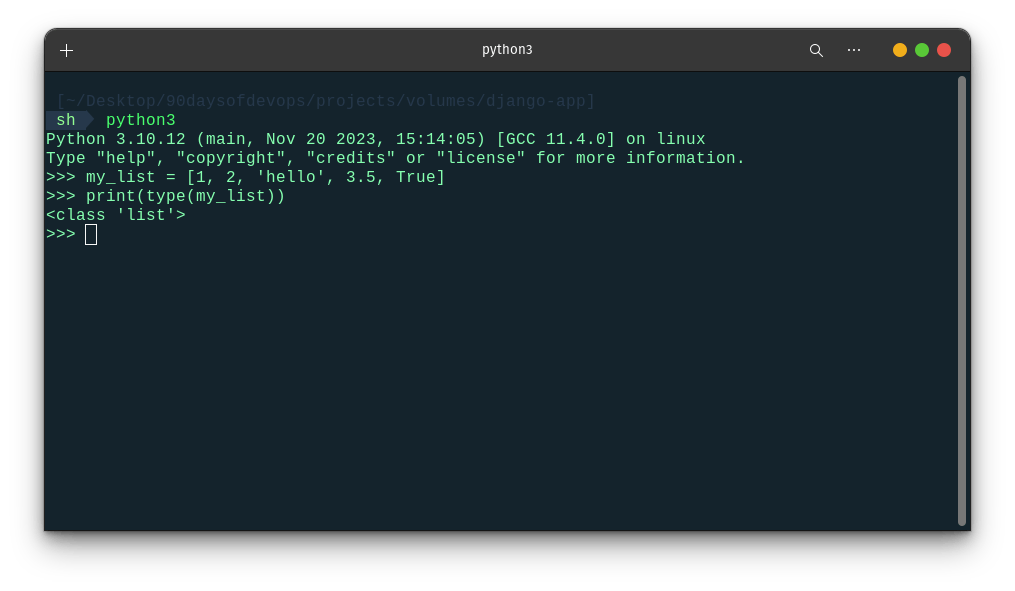Data Types
In the realm of programming languages, understanding data types is akin to knowing the alphabet before you can form words and sentences. In Python, a versatile and widely-used language, grasping data types lays the foundation for building powerful applications. Let's embark on a journey to demystify Python data types, breaking down complex concepts into simple, digestible pieces.
What are Data Types?
Data types categorize the various kinds of data that can be used and manipulated in a programming language.
In Python, data types define the characteristics of data stored in variables, such as numbers, strings, lists, tuples, dictionaries, etc.
Basic Data Types:
a. Integer (int): Represents whole numbers without decimal points.
b. Float: Represents numbers with decimal points.
c. String (str): Represents sequences of characters, enclosed within single or double quotes.
d. Boolean (bool): Represents truth values, either True or False.
Composite Data Types:
a. List: Ordered collection of items, mutable (can be changed).
b. Tuple: Ordered collection of items, immutable (cannot be changed).
c. Dictionary: Unordered collection of key-value pairs.
d. Set: Unordered collection of unique items.
Understanding Mutability:
Mutable data types allow for changes after creation, while immutable data types do not.
Lists and dictionaries are mutable, meaning their elements can be modified.
Tuples and strings are immutable, meaning their values cannot be changed after creation.
Type Conversion:
Python allows for converting data from one type to another, known as type casting.
Functions like int(), float(), str(), etc., facilitate type conversion.
Dynamic Typing:
Python is dynamically typed, meaning you don't need to declare the type of a variable explicitly.
The interpreter automatically determines the data type based on the value assigned to the variable.
Common Operations:
Arithmetic operations (e.g., addition, subtraction) on numerical data types.
Concatenation and manipulation of strings.
Accessing, adding, and removing elements from lists, tuples, and dictionaries.
Data types are the classification or categorization of data items. It represents the kind of value that tells what operations can be performed on a particular data.
Since everything is an object in Python programming, data types are actually classes and variables are instance (object) of these classes.
To check what is the data type of the variable used, we can simply write: your_variable=100type(your_variable)
a = 100
print(type(a))

Data Structures
Data structures serve as the backbone for organizing and manipulating data efficiently. Python, with its simplicity and versatility, offers a plethora of built-in data structures that empower developers to tackle a wide range of tasks. Let's embark on a journey to unravel the mysteries of Python data structures, demystifying complex concepts for beginners.
What are Data Structures?
Data structures are specialized formats for organizing, storing, and manipulating data.
In Python, data structures are used to represent collections of data, each with its own unique characteristics and functionalities.
Lists:
Lists are ordered collections of items, enclosed within square brackets [].
They can contain elements of different data types and are mutable, meaning they can be changed after creation.
Common operations include appending, removing, and accessing elements by index.
list1 = ["apple", "mango", "pineapple"]
Tuples:
Tuples are similar to lists but are immutable, meaning their elements cannot be changed after creation.
They are defined using parentheses () and are often used to represent fixed collections of items.
Tuple packing and unpacking allow for easy assignment of multiple values.
t1 = ("Porsche", "Ferrari", "Lamborghini")
Dictionaries:
Dictionaries are unordered collections of key-value pairs, defined within curly braces {}.
Keys are unique and immutable, while values can be of any data type.
Dictionaries provide fast lookup and retrieval of values based on keys.
tdict = { "brand": "Ferrari", "model": "Purosangue", "year": 2024 }
Sets:
Sets are unordered collections of unique elements, enclosed within curly braces {}.
They are highly efficient for testing membership and eliminating duplicate values.
Set operations such as union, intersection, and difference are supported.
osSet = {"Windows", "Mac", "Linux"}
Understanding Usage Cases:
Lists are versatile and commonly used for storing sequences of items, such as names, numbers, or objects.
Tuples are preferred for immutable collections, like coordinates or configurations.
Dictionaries excel in scenarios requiring fast lookup, such as storing user information keyed by usernames.
Sets are useful for tasks like removing duplicates from a list or checking for common elements between multiple sets.
Built-in Functions and Methods:
Python provides a rich set of built-in functions and methods for working with data structures.
Functions like len(), max(), min(), and sum() offer insights into the characteristics of data structures.
Methods like append(), remove(), and keys() provide convenient ways to manipulate and access elements.
Tasks:
Explain the difference betweeen List, Tuple and Set with Screenshots
Lists:
Lists are ordered collections of items in Python.
They are mutable, meaning you can change their elements after creation.
Lists are defined using square brackets
[].Elements in a list can be of different data types.
Example:
my_list = [1, 2, 'hello', 3.5, True]
Tuples:
Tuples are similar to lists but are immutable, meaning you cannot change their elements after creation.
They are defined using parentheses
().Tuples are commonly used for fixed collections of items.
Example:
my_tuple = (1, 2, 'hello', 3.5, True)
Sets:
Sets are unordered collections of unique elements in Python.
They are defined using curly braces
{}.Sets do not allow duplicate elements.
Example:
my_set = {1, 2, 3, 4, 5}
Here's a brief comparison:
| Feature | List | Tuple | Set |
| Mutability | Mutable | Immutable | Mutable |
| Definition | Defined with [] | Defined with () | Defined with {} |
| Order | Ordered | Ordered | Unordered |
| Duplicates | Allowed | Allowed | Not Allowed |
Create below Dictionary and use the dictionary methods to print your favourite tool just by using the key of the Dictionary
fav_tools ={
1:"Linux",
2:"Git",
3:"Docker",
4:"Kubernetes",
5:"Terraform",
6:"Ansible",
7:"Chef"
}
# Define your favorite tool's key
favorite_tool_key = 2 # Change this to your favorite tool's key
# Printing your favorite tool using its key
print("My favorite tool is:", fav_tools[favorite_tool_key])

Create a list of Cloud Service Providers
# Create a list of cloud service providers
cloud_providers = ["AWS", "GCP", "Azure"]
# Add Digital Ocean to the list
cloud_providers.append("Digital Ocean")
# Sort the list in alphabetical order
cloud_providers.sort()
# Print the sorted list
print("Cloud Service Providers (Sorted):", cloud_providers)

"Fuel my passion and support my journey by clicking 'Buy me a coffee' today!"
~Dipen : )

